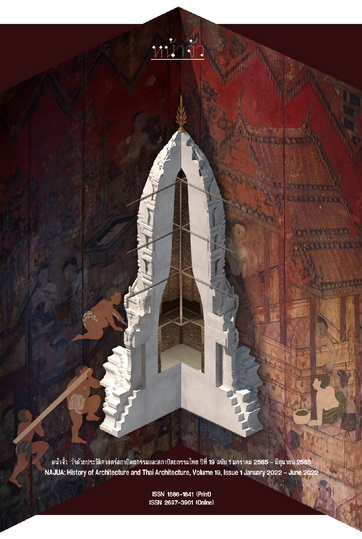Cultural Storytelling through Public Facilities in Ban Chak-Ngaew Chinese Old Town
Main Article Content
Abstract
Vernacular commercial communities are considered as an important cultural heritage, but many of them are fading away or abandoned. Some of these subdued communities have been tried to revitalize themselves through tourism management. Even though some of built environments for public facilities are perhaps required for tourism, these somehow can affect the local image. This paper aims to illustrate an approach to develop public facilities that can inform cultural story of a vernacular commercial community, which were rehabilitated under community-based tourism. Data were obtained from observation and interviews with one of the committees of Ban Chak-Ngaew Chinese old town in Chonburi province. This community was selected because it is considered as a role model, operating community-based tourism successfully. This study found that most built environments for public facilities in Ban Chak-Ngaew Chinese old town came from the resources of their cultural heritages, in which some were obsoleted or disappeared from everyday usage. Most of them are presented through exhibition methods along with tourism activities. Especially, an artesian well and its placewas intentionally constructed with the purpose for communicating their cultural meaning as a public space for social interaction, thus becoming public space of acculturation. Overall development of public facilities for tourism of this community suggests an alternative way to present community identity as well as an approach for improving community-based tourism.
Downloads
Article Details

This work is licensed under a Creative Commons Attribution-NonCommercial-NoDerivatives 4.0 International License.
References
Bundesministerium Für Wirtschaft Und Arbeit. ARCHITECTURE IN TOURISM: Analysis of the interaction between architecture and tourism. Accessed May 15, 2007. Available from http://www.platou.at/portal3/images/stories/Download/amg_summary.pdf
Chatri Prakitnonthakan. Retro market nai krasǣ nostalgia tourism čharit chon chan klāngmai kap kān hōihā ʻadīt [Retro market in the movement of Nostalgia Tourism-Middle class norms and Nostalgia]. Accessed May 21, 2021. Available from https://www.tatreviewmagazine.com/article/retromarket-nostalgiatourism/
Chawalee Na Thalang, Pakamas Chairatana and Krirkkit Chairatana. “kānčhatkān kānthō̜ngthīeo dōi chumchon talāt Čhīn bān chāk ngǣo ʻamphoē bānglamung čhangwat Chon Burī [Management of community-based tourism: A case of Baan ChakNgaeo Chinese Market, Bang Lamung District, Chonburi Province].” SSRU Graduate Studies Journal 13, 1 (January-June 2021): 29-46.
Designated Areas for Sustainable Tourism Administration (Public Organization). kānthō̜ngthīeo dōi chum chom yāng yangyư̄n [Sustainable community-based tourism]. Accessed February 2, 2022. Available from https://www.tatreviewmagazine.com/article/cbt-thailand/
European Network for Accessible Tourism. Services and facilities for accessible tourism in Europe. Accessed August 2, 2019. Available from https://www.accessibletourism.org/resources/enat_study-2_services_and_facilities_en.Pdf
Huai Yai Subdistrict Municipality, Bang Lamung District, Chonburi Province. saphāp sangkhom [Social conditions]. Accessed October 24, 2022. Available from http://www.huayyai.go.th/general3.php
Jitrasak Putjorn and others. khūmư̄ kānpramoēn khīt khwāmsāmāt nai kān rō̜ng rap khō̜ng lǣng thō̜ngthīeo nai phư̄nthī chumchon yān mư̄ang kao [Handbook for carrying capacity assessment of tourism attractions in the old town community areas]. Bangkok: Chulalongkorn University, 2020.
Katchaphon Janpetch and Phitak Siriwong “kārabūn nā kān thun thāng watthanatham sū kān pen lǣng thō̜ngthīeo choēng sāngsan dūai krabūankān mī sūan rūam khō̜ng chumchon: kō̜ranī sưksā chumchon bān chāk ngǣo ʻamphoē bānglamung čhangwat Chon Burī [The integration of cultural capital into a creative tourist attraction through participatory process: A case study of Ban Chak Ngaew community, Bang Lamung District in Chonburi Province].” Journal of Community Development Research (Humanities and Social Sciences) 10, 1 (January-March 2015): 111–121.
Methee Piriyakarnnon and Nopadon Thungsakul. “parithat botkhwām: rư̄ang phư̄nthī sāthārana phư̄nthī thāng watthanatham læ phư̄nthī sāthārana thāng watthanatham [Article review: Public space, cultural space and public cultural space].” NAJUA: History of Architecture and Thai Architecture 18, 1 (January-June 2022): 134-158.
Nalikartipak Sangsanit. “sān čhāk phū ʻamnūai kān ʻaphot [Message form the director of DASTA].” In sarup sēwanā: wēthī rūamphon khon thō̜ngthīeo dōi chumchon CBT Forum by DASTA tō̜n Story Telling: rūamphon... khonhā khwāmmāi [Seminar conclusion: Gathering stage…CBT People in CBT Forum by DASTA in the session of “Story telling: gathering…searching for meanings], 1-3. Bangkok: Designated Areas for Sustainable Tourism Administration (Public Organization), 2018.
Nipha Chuchaiwattanasak. Local people in Ban Nhong Chak-Ngaew, Huai Yai Subdistrict, Bang Lamung District, Chonburi Province. Interview, October 17, 2020.
Office of Tourism Destination, Office of Tourism Development, Ministry of Tourism and Sports. khūmư̄ khrư̄akhāi kānthō̜ngthīeo dōi chumchon [Handbook for community-based tourism network]. Bangkok: Office of Tourism Destination, 2007.
Orbasli, Aylin. Tourists in historic towns: Urban conservation and heritage management. New York: Taylor & Francis, 2009.
Ornsiri Panin and Somkid Jiratatsanaku. “Introduction.” In rư̄an khākhāi phư̄n thin nai chumchon mư̄ang [Commercial vernacular houses in the city communities], 1-4. Bangkok: J. Print, 2001.
Phukrirk Bausorn. “kān fư̄nfū talāt kao nai mư̄ang Thai [The revitalization of the old markets in Thailand].” Veridian E-Journal SU, no. 4 (May-August 2011): 36-55.
Ram, Yael, Peter Björk, and Adi Weidenfeld. “Authenticity and place attachment of major visitor attractions.” Tourism Management 52 (2016): 110-122
Snodgrass, Adrian. “Introduction].” In sanyalak hǣng phra sathūp [Symbols of pagoda], 1-10. Translated by Pattraporn Sirikarn and others. Bangkok: Amarin Printing and Publishing, 1998.
Somrak Chaisingkananont. talāt nai chīwit chīwit nai talāt [Market in life-Life in market]. Bangkok: Princess Maha Chakri Sirindhorn Anthropology Centre, 2006.
Wandee Pinijvarasin. “kān fư̄nfū chumchon talāt sān čhao rōng thō̜ng lang phloēng mai sō̜ngphanhārō̜isīsippǣt [Rehabilitation of San Chao Rong Thong market community after the fire in 2005].” NAJUA: History of Architecture and Thai Architecture, no. 15 (January-December 2018): 142-171.
Yajun, Yang. “chumchon bān chāk ngǣo: kān fư̄nfū læ kān damrong yū (Phō̜.Sō̜. sō̜ngphanhārō̜ihāsipsō̜ngsō̜ngphanhārō̜ihāsippǣt [Ban Chak-Ngaew community: Reconstruction and revival during A.D.2009-2015].” Master Thesis, Faculty of Humanities and Social Sciences, Burapha University, 2017.
Yongtanit Pimonsathea. “praden wikrit rư̄ang kānʻanurak chumchon prawattisāt nai mư̄ang samrap prathēt Thai [Critical issues on the conservation of historic urban community for Thailand].” NAJUA: History of Architecture and Thai Architecture, no.9 (September 2012–August 2013): 101-119.


